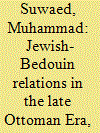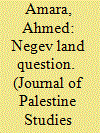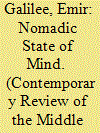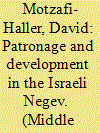| Srl | Item |
| 1 |
ID:
189421


|
|
|
|
|
| Summary/Abstract |
The complex relationship between Bedouins and Zionist pioneers in the Land of Israel during the late 19th and early 20th centuries evolved along two parallel tracks: conflict and cooperation. The former was a corollary of the sociocultural gap between the pioneers and the Bedouins and revolved by and large around the diametrically opposed views regarding land ownership rights and their implications (e.g. access to water, grazing). The latter was a result of the growing Bedouin realisation that the Zionist project was there to stay: the more the Jewish pioneers proved their determination to cultivate their lands and defend themselves the more they won Bedouin respect, or at least grudging acquiescence, which in turn evolved to wider recognition of the vast socioeconomic benefits of peaceful coexistence.
|
|
|
|
|
|
|
|
|
|
|
|
|
|
|
|
| 2 |
ID:
124265


|
|
|
|
|
| Publication |
2013.
|
| Summary/Abstract |
This article explores the legal issues and policies surrounding Bed- ouin land ownership and dispossession in the Negev. By tracing the colonial legal trajectory-from Ottoman to British and finally, to the current Israeli adoption and development of legal doctrines- the author exposes an intricate manipulation of historical legal policies being used to further displace tens of thousands of Bed- ouin Arabs living in the Negev today. This displacement is further contextualized as not only legally steeped in colonial heritage, but also as part and parcel of an active, larger colonial Judaization scheme by the Israeli state towards its Palestinian citizens. This article discusses the most recent of these schemes in the Negev: the Prawer Plan.
|
|
|
|
|
|
|
|
|
|
|
|
|
|
|
|
| 3 |
ID:
169984


|
|
|
|
|
| Summary/Abstract |
This article is based on over a decade of field research among Bedouin tribes of the Negev as well as historical and geographical research. Its central argument is that the main social, cultural, and geographical processes within the Negev Bedouin groups are impacted by three major forces: nomadism and the social structure; formal Islam; and the rise of the modern state. This argument is illustrated by the geographical concept of “mental maps”, and its various manifestations in Bedouin society. The article focuses on the historical developments of the twentieth century, which took place alongside the rise of the Zionist movement and the establishment of the State of Israel.
|
|
|
|
|
|
|
|
|
|
|
|
|
|
|
|
| 4 |
ID:
174155


|
|
|
|
|
| Summary/Abstract |
The article focuses on the early stages of the colonization of the Israeli Negev during the 1950s. It reconstructs the early stages of the settlement of Yeruham from the perspective of one local administrator, Shlomo Tamir, who managed the settlement for a one-year period, 1952–1953. Conceptualizing Tamir’s role as that of a mediator, it draws attention to the forming political structure of patronage and clientelism on the local level and the concomitant changes in the ‘big-man’ networks of pre-state elite networks as they expanded into Israel’s southern frontier. A micro historical analysis focused on Tamir’s deputies furnishes a discussion on the social make-up of the Israeli frontier, comprising of a typical frontier mixture of fortune seekers, opportunity hunters, semi-indentured laborers and upwardly mobile colonists.
|
|
|
|
|
|
|
|
|
|
|
|
|
|
|
|